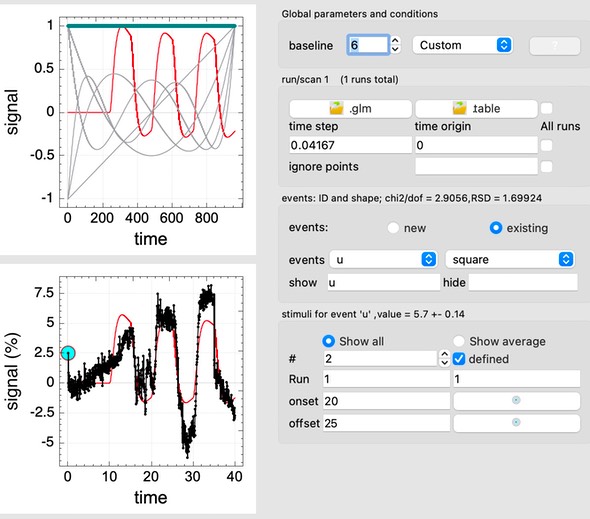A time-series analysis for fMRI data is provided using the general linear model (GLM); for a brief refresher on the GLM, see here.

Event identifiers
In the usual GLM parlance, an "event" is a stimulus or a series of stimuli of some specified shape that becomes a single regressor within the model. An event may be specific to one run or span a series of runs. When fitting data, a single scaling factor is applied to each event, and the magnitude of the event (or scaling factor) can be tested for statistical significance. Event shapes correspond to an expected model for the neural response (e.g, rapid on/off, or slow wash-in and wash-out of drug).
To keep i/o simple on the display user interface, all events are denoted by a single numeric or alphabetic character (1-9, a-z, A-Z). WARNING: The Mac OS X file system does not distinguish between upper and lower case, so do not use a small and capital event (e.g., a & A) in the same GLM on Macs.
Event shapes
For sensorimotor or cognitive stimuli, the standard event type is "square", meaning that neural function increase and decreases very rapidly (instantaneously) relative to the response of the blood supply (with which the square shape can be convolved). "ramp-up" and "ramp-down" events are similar to the "square" event are generally are used only to test assumptions about the neural response. "gamma" events take the form t/tau*exp(-t/tau) and generally represent drug stimuli that first increases and then resolves. Alternatively, one might use a "sigmoidal" event for a response that maintains an elevated/decreased state at later times. A "table" event points to a column in a table file that is associated with each run. This event allows non-parametric data (e.g., blood pressure, behavioral indices, motion-correction parameters, ...) with one value per time point. ASL events provide a sawtooth model for alternate tagging/control in arterial spin labeling. Interaction events are products of other events. Sine and cosine events are rarely used and have been tested less well by me.
One can use predefined hemodynamic response functions or fit the HRF using a finite-impulse response (FIR). Alternatively, a response can be fit as a finite response (FR) of defined length.
Conditions
Conditions are statistical tests on the magnitude of a single event or the net magnitude of sums or differences of events. For instance, if there are two events defined in the GLM with names L and R for stimulation of a left or right sensorimotor area, then one might want to create statistical maps corresponding to the individual events, the average of events, or the difference of events. The average of events is specified by just concatenating the individual events to be "LR". The difference of the two events could be either "L-R" or "R-L". If there were 4 events labeled as 1, 2, 3, and 4, then condition 12-34 means "+1+2-3-4", so that everything that occurs after the "-" sign is negative (summed values are divided by the number to create an average).
One can create F tests as well as T tests. An F test, which asks if either of one or more specific tests reached significance, is created by inserting a comma. The condition "L,R" is an F test for either L or R, whereas "LR" is a T test for the sum of L and R.
Multiple conditions are listed together with one or more spaces separating them in the GLM control file: "conditions L R L-R”
Impulse response functions (IRF or HRF)
A hemodynamic response function (HRF) is just an impulse response function (IRF) that models the response of the blood supply in relation to the presumed neural response. A common form of this IRF is the gamma-variate function (e.g., Boyton 1996), or sums of several gamma-variate functions. Instead, this GLM implementation instead uses sums of exponential functions:
![]()
There is no particular advantage to either type of IRF form, although with exponentials, the dominant time constants can be more easily viewed from the data. Convolution of an exponential (exp(-t/tau)) with a step function yields another exponential (1-exp(-t/tau)). The two dominant time constants in BOLD signal are the initial positive response (for "activation" assuming a square neural response) and a post-stimulus undershoot. The two dominant time constants for the IRON response are a rapid and a slow component of increasing CBV.
In this GLM, the IRF can be specified using built-in functions or modified by a popup menu that is activated by the button next to the IRF selection combobox. Modified IRFs can be useful to tweak a response for different species, or to model something that is not driven purely by the response time of the blood supply (e.g., a response to repeated hypercapnia). Popup windows enable users to define the 3 time-constants (onset delay, fast response, slow response) and two weights (fast, slow); the third weight is constrained by the condition that the IRF=0 at time=0.
If an IRF is specified in the GLM, then all events except table events are convolved with the IRF in order to form the regressors that are included in the design matrix.